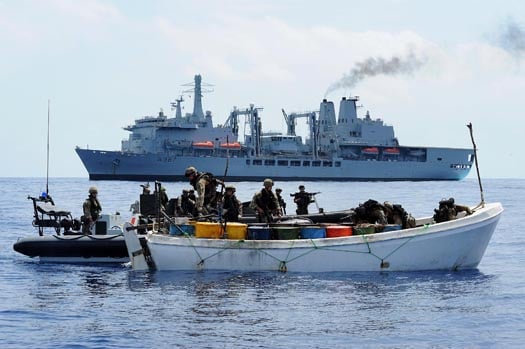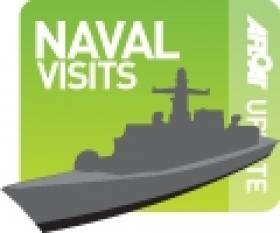Displaying items by tag: Royal Navy
University Challenge Heads for Cork
#NAVAL VISITS – Two small University Royal Naval Units (URNU) patrol training boats of the Royal Navy are due to call to Cork city centre along South Customs House Quay this afternoon, writes Jehan Ashmore.
The pair are HMS Exploit (P167) and HMS Express (P163) and they belong to a 14-strong P2000 Archer Fast Inshore Patrol Class. They form the First Patrol Boat Squadron and their primary role is to support the URNU but they also contribute to a wide range of fleet tasking.
Each vessel displaces 54 tonnes and has a crew of five on a boat that is just over 20m and draws a draft nearing 2m. Top speed is 22 knots and they can cover a range of 550 nautical miles.
HMS Exploit is the Birmingham University Royal Navy Unit's Training Patrol vessel, although the unit covers a wide area, taking undergraduates from eight Universities in the region. She was built by Vosper Thornycroft and commissioned in 1988. The boat is berthed in Penarth Marina, near Cardiff.
Likewise HMS Express is based at Penarth, she too provides sea training and offers an insight into the modern Royal Navy for Wales URNU undergraduates drawn from Cardiff, Swansea and Glamorgan Universities and University of Wales Institute Cardiff. Last year she took part in the Three Peaks Challenge.
The patrol boats follow last month's call also to the city of the Marine Protection Vessel (MPV) Jura which at 84m long makes her the largest of the three-strong Marine Compliance Scotland fleet. On that occasion she docked opposite at the North Customs House Quay.
Scottish Search and Rescue Base UK's Busiest in 2011
#RESCUE - The Royal Navy search and rescue unit at HMS Gannet was the busiest in the UK last year, STV News reports.
The unit - based in Prestwick, near Glasgow - responded to nearly 300 call-outs and rescued 240 people in Scotland, northern England and Northern Ireland throughout 2011 with its fleet of Sea King helicopters.
The big numbers put HMS Gannet at the top of the UK's 12 search and rescue units for the fifth year running.
"Like all emergency services, we work under significant pressure and always aim to provide the best service we possibly can," said HMS Gannet's Lieutenant Commander Debdash Bhattacharya. "Frequently lives depend on it."
Since 2007 the unit has rescued 1,575 people from 1,865 call-outs in total. Last year's call-outs represented 17% of all call-outs from military bases in the UK.
STV News has much more on the story HERE.
Help Record Old Weather Data to Predict Climate's Future
#WEATHER - A new project has been launched encouraging web users to help recover worldwide weather data recorded by Royal Navy ships a century ago.
Old Weather is 'crowdsourcing' volunteers to assist in transcribing weather readings and location data from First World War ships' logs into a database, in order to identify weather patterns and extremes the world over.
At present the site needs help transcribing data from 27 Royal Navy vessels and the courses they sailed, from Britain and Ireland to the farthest reaches of the globe.
The more people that take part in Old Weather, the more accurate the data extracted from the ships' logs will be.
Each logbook will be also looked at by more than one person, allowing mistakes and errors to be filtered out.
The historical data will enable scientists to improve their understanding of weather variabilty in the past and in turn improve their ability to predict weather and climate in the future.
For more details visit www.OldWeather.org.
NATO Foils Pirate Attack
#PIRATES– On 28 November, the Royal Navy vessel, RFA Fort Victoria was patrolling in an area approximately 420 nautical miles from the Seychelles and 350 nautical miles from the Somali coast as part of NATO's counter piracy task force 508.
Early that morning, she received information that a Spanish fishing vessel operating to the north of their position had come under attack from a group of pirate vessels to the North of their position. The ship's Lynx helicopter was quickly despatched to investigate.
Once at the scene, the helicopter identified two suspect vessels, a whaler and a skiff, in the vicinity of the fishing vessel. The faster of the two, a skiff, sped away at over 25 knots as the helicopter gave chase. When the skiff ignored orders to stop, the Lynx helicopter fired warning shots ahead of the fleeing vessel which stopped and the suspected pirates onboard were then transferred to Fort Victoria via boat.

RFA Fort Victoria was approached by a pirate skiff at speed as they attempted to board her, However after Fort Vic laid down warning shots using their Miniguns the pirates had a sudden change of heart and started to make a run for it. Fort Vic gave chase and launched her boarding teams to stop them.
Fort Victoria's Royal Marines boarding team then boarded the whaler and another skiff in the vicinity. As a result of the day's action, a total of seven suspected pirates were detained onboard Fort Victoria along with their whaler as evidence, with no injuries being sustained by either side.
Captain Gerry Northwood Royal Navy, embarked in Fort Victoria said:
"It has been a long but rewarding operation with many complex aspects. Operating under NATO tasking and in consultation with our headquarters in the Middle East and in the UK, we utilised a range of national and international assets to bring these events to a satisfactory conclusion. Fort Victoria has once again demonstrated that multinational coordination can be successfully deployed to disrupt piracy in this area in order to protect international merchant shipping."
Anglo-Irish Relationships
#NAVAL VISITS- HMS Tyne (P281) the leadship of four River-class Fishery Protection Vessels is due to dock in Dublin Port tomorrow, in the meantime her allocated berth is currently taken by a former Royal Navy (RN) vessel now serving in the Irish Naval Service (INS), writes Jehan Ashmore.
The INS L.É. Ciara (P42) docked at Sir John Rogersons Quay (berth No.8) yesterday evening after spending the previous day with a call to Dun Laoghaire Harbour's St. Michaels Wharf. Tomorrow she is due to depart in advance of HMS Tyne's morning arrival.
Unusually she and her three sisters are leased to the RN from BAE Systems (who retain responsibility for any major maintenance and upkeep) and shipbuilding partners, Vosper Thornycroft, Southampton which built all of the River-class. To read more about the quartet click HERE.
L.É. Ciara was originally launched as HMS Swallow (P242) at Hall Russell Shipyard, Aberdeen and in 1984 was commissioned for the RN, forming one of five 'Peacock' class coastal patrol vessels (CPV). She served her entire RN career with sisters designed specifically for the Hong Kong Squadron.
In 1988 the INS purchased her alongside a sister HMS Swift (P243) and the pair set sail from the UK colony for Cork Harbour. L.É. Ciara and her sister which became L.É. Orla (P41) were commissioned into the service after a ceremony performed by An Taoiseach C.J. Haughey at the Naval Base in Haulbowline.
Amongst the eight-strong INS fleet is L.É. Emer (P21) commissioned in 1978, an improved version of the Deirdre-class offshore patrol vessel (OPV). She appeared along with a sister of the River-class ship, HMS Severn in the Irish language river series 'Abhainn' which returned to our screens on RTE 1 last month, during the episode about the River Foyle /An Feabhal. The naval vessels were attending 'Foyle Days' in May as previously reported on Afloat.ie
- Irish Naval Service
- Dublin Port
- naval service
- Royal Navy
- Dun Laoghaire Harbour
- Peacock Class
- Hall Russell
- Foyle Days
- Naval Visits
- River Foyle
- Coastal Patrol Vessels
- HMS Tyne
- RN
- INS
- Hong Kong Squadron
- Fishery Protection Ship
- BAE Systems
- Vosper Thornycroft
- Haulbowline Naval Base
- Deirdreclass
- Abhainn TV series
- HMS Severn
- Irish River TV series Abhainn
Duke-Class Frigate Docks In Dublin
She measures 133m (436ft) long and on a beam of 16.1m (52.9ft) and has a crew compliment of 185 in total. An array of highly sophisticated arnament is packed on board in addition she can convey a Lynx helicopter. Propulsion is derived from a combined use of diesel and gas (CODLAG) .To read more about the penultimate Type 23 class and her sisters click HERE
Royal Navy Office for Offshore Yachtswoman Caffari
Caffari, who set her third world record earlier this year by sailing non-stop around the planet more times than any other woman in history, joins the likes of adventurer Bear Grylls and fellow British yachtswoman Dame Ellen McArthur who have both received similar naval distinctions. On receiving the news that her appointment had been approved by Her Majesty Queen Elizabeth II, a delighted Caffari said:
"It is an honour to be recognised for my achievements and support of the armed forces. I have enjoyed the links I have established and maintained with the Royal Navy and look forward to being presented with my uniform! Having not worn a uniform since school, I am excited about preparing for my role at Dartmouth, being fitted with a uniform and learning to salute correctly"
One of the main links Caffari has with the navy is through her work as an ambassador for the tri service initiative, Toe In The Water. The volunteer based charity uses competitive sailing as a direct extension of the rehabilitation programmes carried by the Defence Medical Rehabilitation Centre (DMRC) Headley Court to re-inspire profoundly and traumatically injured service personnel to explore life beyond their injuries. Caffari first competed with Toe in the Water at the Dartmouth Regatta in 2009 and has continued to work closely with them since them, racing alongside many injured and able-bodied Royal Navy and Royal Marines crew members, as well as soldiers and airmen.
Director General of Army Medicine and Toe in the Water Chairman, Major General M von Bertele OBE commented:
"Dee has been a great inspiration to many of our injured servicemen and women and her energy, genuine enthusiasm and commitment to the work we do is invaluable. It's great to see her dedication and passion recognised in this way."
Caffari's next goal is to compete in the Vendée Globe 2012 with the intention of securing a podium position and the search for a new title sponsor to support her on-going sailing campaign continues.
Navies Northern Adventure Head for 'Foyle Days'
On the naval front, LE Emer was built in Cork's Verolme Dockyard in 1978. She represents the oldest of the eight-strong fleet and is designed from the Naval Service's first purpose built patrol vessel OPV LE Deirdre (P20) but was modified to improve her stability and speed. This vessel was decommissioned several years ago and was converted into a private yacht.
The original BOFORS 40mm L60 gun of the LE Emer was recently upgraded to a BOFORS 40mm L70 to improve range and accuracy of her main armament. She alongside her 65m sisters LE Aoife (P22) and LE Aisling (P23) where all built primarily to patrol the Irish section of the European Economic Zone (EEZ).
During their careers the 'Emer' class vessels have also completed numerous re-supply missions to Irish troops serving overseas with the United Nations and in particular in the Lebanon. A crew compliment of 46 (5 officers) operate the vessels which are all now in their fourth decade of service.
OPV HMS Severn is the third of four 'River' class offshore patrol vessels and like her Irish counterpart is deployed on fishery duties. The 1,677 displacement tonnes vessel was built in 2001 in the UK'S south coast port of Southampton at Woolston Docks. Her home port for the 30 crew is at HM Naval Base in neighbouring Portsmouth.
She becomes the fifth ship to bear the name and with sisters HMS Mersey (P 282) and HMS Tyne (P 281) they are assigned to the Fishery Protection Squadron. Click the ship's diary to follow the ship news. The final member of the River class HMS Clyde (P 257) serves as a Falklands Islands Patrol Vessel (FIPV).
- yacht
- Clipper Round The World Race
- naval service
- Derry
- Royal Navy
- Londonderry
- Ports and Shipping News
- JOHANNA LUCRETIA
- Verolme Cork Dockyard
- United Nations
- Foyle Days
- Offshore Patrol Vessel
- Maritime Festivals
- LE Emer
- Emerclass
- LE Deirdre
- HMS Mersey
- Riverclass
- Schooner
- HM Naval Base Portsmouth
- Falklands Islands
Navy Escort Detained Trawler to Castletownbere
Less then a month ago the Naval Service detained a Northern Irish registered fishing vessel the Lynn Marie seven miles east off Bray Head. Onboard was a crew of 4 UK nationals who were taken into custody to the Gardai after the trawler was escorted by the CPV L.E. Orla to Dun Laoghaire Harbour. To read more about this detention click here.
Ironically the L.E. Orla was a former Royal Naval vessel, HMS Swift (P241) which was deployed on her first assignment to the Hong Kong Patrol Squadron for a four-year period. In 1988 Margaret Thatcher's Conservative Party Government disposed HMS Swift and HMS Swallow (P242) to the Irish Naval Service. The pair were built by Hall Russell Shipyard of Aberdeen as part of an eight 'Peacock' class coastal patrol vessel (CPV).
The 'Peacock' pair were commissioned into the Naval Service and renamed L.E. Orla (P41) and L.E. Ciara (P42) in a ceremony attended by An Taoiseach Charles J. Haughey at the Naval Base in Haulbowline, Cork Harbour.
This weeks' detention is the second conducted by the Naval Service in 2011. Last year the Naval Service carried out 1,666 vessel boardings which resulted in 70 warnings and eight detentions.
- Irish Naval Service
- Cork Harbour
- Northern Ireland
- Haulbowline
- castletownbere
- naval service
- LE Niamh
- Royal Navy
- Ports and Shipping News
- Lynn Marie
- Fishery Breaches
- Fishery Detention
- Fishing Trawler
- Peacock Class
- Hong Kong
- Hall Russell
- Appledore Shipbuilders
- LE Orla
- HMS Swift
- LE Ciara
- HMS Swallow
- Margaret Thatcher
- Conservative Party
- An Taoiseach
- Charles J. Haughey
- Naval Base
Passing of Irish Naval Service Officer Commander
Following his retirement in September 1980 he worked with Irish Shipping Ltd for a further five years during the construction of the state-owned company ships at the Verolme Cork Dockyard. At the same dockyard, he had also been closely involved in the design and commissioning of the Naval Service's helicopter patrol vessel L.É. Eithne, its largest vessel which was built in 1984.
To read more about the distinguished career of Cdr Liam Ahern and also his wartime role in the Royal Navy, his obituary is published in today's Irish Times.
Jehan Ashmore adds that the L.É. Eithne arrived into Dublin Port this morning to dock at Sir John Rogersons Quay next to the French Navy minehunter Cassiopée (M642) and mine-route survey craft Altaïr, which have been on a visit to the capital for the St. Patrick's festivities.
At 1,760 tonnes the L.É. Eithne is not only the largest vessel of Ireland's eight-strong fleet but is also the last ship of any type built in the Republic of Ireland. For a photo of the 27-year-old ship seen off Cobh (where Cdr Ahern was born) click here.
The 80m vessel has a crew of 85 (9 Officers and 77 ratings). Her main armament is a Bofors 57mm anti-aircraft gun with a LIOD fire control system and two 20mm Rheinmetals.
In 1986 L.É. Eithne made a historic visit as the first Irish Naval Service ship to cross the Atlantic, where she sailed to the United States, visiting Hamilton, New York and Boston. A decade later she became the first Irish Naval ship to tour the continent of South America.





































































